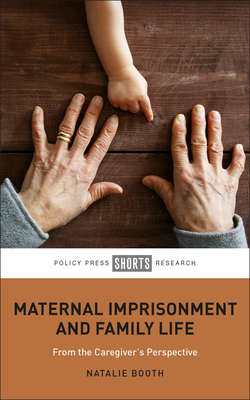Читать книгу Maternal Imprisonment and Family Life - Booth Natalie - Страница 10
ОглавлениеFamily constructions and caregiving practices
Introduction
This chapter examines the nature and scope of caregiving practices within families to better understand how families can be constructed during maternal imprisonment. Although there is growing international awareness of the ‘collateral consequences’ of imprisonment on children and families (Gordon, 2018; Condry and Scharff Smith, 2018), Jardine (2018) suggests that this has tended to focus narrowly on the prisoners’ immediate families. There is much still to be learned about the caregiving arrangements within families and the ways in which these can shape family life during maternal imprisonment. Importantly, caregivers in this study explained how the repercussions of losing the mothers to prison were felt by many relatives and friends within their kinship networks. Although varied and complex, this depended upon their family constructions, interactions and engagement in – or exposure to – caregiving practices. The three distinct characteristics that were observed within families are discussed in this chapter.
First, the joint interviews (see Chapter Two) reveal something important about the way in which families were collectively responding to the mothers’ imprisonments. Both the joint interviews and caregivers’ descriptions show the meaning, nature and value of collective caregiving practices within the families, facilitating nuanced insights into the families’ shared responses to the mothers’ imprisonments. The value of using Morgan’s (2011) theoretical concept of ‘family practices’ is apparent as discussions about ‘family’ are active, subjectively defined and not restricted to the household (see Chapter Two).
Second, following previous research (Caddle and Crisp, 1997; Raikes, 2016), the majority of the children were being looked after by women, either solely or alongside their partners or other female kin. Codd (2008) has argued that caregiving and support for prisoners and their children falls to female relatives in the family. The findings here not only support these gendered caregiving trends, but also indicate that during a mother’s imprisonment, it is maternal kin who take on these responsibilities. Importantly, the new caregiving responsibilities for these women had implications for their own children and other grandchildren in the family. Therefore, it is important that discussions about maternal imprisonment consider the needs and experiences of this other group of ‘doubly’ invisible children.
Third, one explanation for female relatives assuming the bulk of care may be the smaller uptake of care from the children’s fathers. Previous research has indicated that only 10 per cent of children reside with their fathers during maternal imprisonment (Caddle and Crisp, 1997) and, similarly, father-caregivers were identified in just three families in this study (see Chapter Two). In two of these, (step)father-caregivers1 (Daniel and Kevin) were looking after both their biological children and stepchildren. There has been little qualitative research that has attempted to understand why fathers are generally found to play a smaller caregiving role to children, though this is assumed to reflect wider gendered caregiving trends in society (Codd, 2008). Discussions in the final section of this chapter explore the positionality of the children’s fathers, as well as father–children relationships, from the perspectives of caregivers.
Joint interviews and collective caregiving
There are possible gains in observing how many of the families wanted to talk about their experiences of caregiving in a joint interview (see Chapter Two). Although, in most instances, the interview had been arranged with one family member, other kin were present at the scheduled interview and wanted to take part. Both were offered a consent form and agreed to be interviewed together. Analysis of the joint interviews indicated that this collective participation in the interview reflected the shared approach that many families adopted in managing the mother’s absence. Frequently, phrases like ‘we have’ or ‘we think’ were used, discursively illustrating their shared experiences, conceptualised here as collective caregiving. This can be seen in the exchange between two primary kin caregivers, Lucy and Kristen, who were explaining how ‘they’ felt, and how they were responding to the first few days following the mother’s removal into prison:
Lucy:‘We just felt completely overwhelmed, you know, crying, in shock, you know, feeling sick, not being able to eat, we just…’
Kristen:‘Like, what we gonna do?’
Lucy:‘Yeah, like, what we gonna do? How long’s it gonna be? How long has she got to serve? You know, I’ve got her daughter [saying] “When’s Mummy coming home? When’s Mummy coming home?”’…
Kristen:‘We were just kind of trying to find, like, a routine for us all.’
(Lucy, grandmother; Kristen, cousin)
Similar accounts were also found in joint interviews between primary kin caregivers and other carers. For instance, Janice and Lorraine also articulate their joint response to the mother’s imprisonment:
Natalie2:‘And what do you think about that time, from arrest to being sentenced?’
Lorraine:‘Horrible.’
Janice:‘Horrendous.’
Lorraine:‘Horrid, it were a shock.’
Janice:‘We just lost loads of weight, didn’t we?’
Lorraine:‘Yeah, we couldn’t, we just thought “We’ve got her children to sort out, her house.”’
(Janice, grandmother; Lorraine, friend)
In both of these exchanges, it is clear that the caregivers are working together to communicate their reactions while also revealing how they understood childcare and other tasks to be a shared responsibility. Morgan’s (1999
